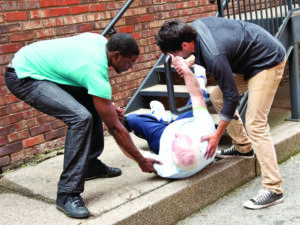By Amandita Johnson
Elderly falls can contribute to decreased mobility, lower quality of life or sudden death. I constantly think about all aspects of aging and longevity and consider falls to be a major discussion point with families and clients. Some aging adults have a fear of falling, so they stop participating in active hobbies like dancing, hiking or bird watching, which can lead to loneliness and isolation.

This subject is personal to me. Both my husband and I have parents who fell, which contributed to their untimely deaths. My mom fell more than once at home while refusing to hire caregivers. My father-in-law was gone for two days before the police were called. They found him on the floor after a cardiac arrest.
None of the 82 scientific studies I’ve investigated suggest only one way or method to surely prevent falls. Of course, canes, walkers, grab bars in the bathroom, reducing clutter and others do prevent or minimize falls. Here are some facts about fall prevention:
• Fall alert systems are not perfect. Personal emergency response systems or PERS are used to contact a crisis line by squeezing a button. While the PERS system can be valuable, it’s useless when the person becomes unconscious or unable to press the button. A recent study says 80 percent of older adults wearing PERS did not use it to call for help after a fall. Aside from PERS, there are several devices a senior can use such as smart shoes/socks, Apple Watch, smart clothing and arm fall alarms. But none of them are perfect, and movements can set off alarms unnecessarily. It’s still good to use something. If you or your loved one is part of the 20 percent who’s able to press the button immediately after a fall, it could save a life.
• Falls are not a part of aging. Yes, adults 65 and older experience falls as frequently as 28–35 percent more than others. However, not all aging adults end up falling. Thousands of them over 70 years old remain active and do things they love.
• Staying home does not avoid falls. As a matter of fact, the National Council on Aging reported 60 percent of falls happen at home. Older adults should be medically seen to check for balance issues. A wide variety of factors contribute to falls. Falls may be caused by foot problems, medication, dehydration, loss of hearing, loss of eyesight, lighting and muscle loss.
The chances of serious injury from a fall are reduced when older adults live in safe communities such as retirement homes or assisted living. Most independent living apartments employ safety procedures and are engineered to prevent falls. Think about the results if you or your loved one falls at home alone versus being checked by a caregiver or staff in a community. Preventing falls can reduce healthcare expenses.
